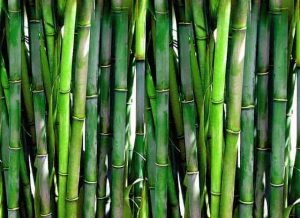How To Grow Bamboo From Seeds

Do you want to learn how to grow your bamboo from seeds?
If your answer is yes, then you are at the right place.
This article will guide you on how to grow bamboo from seeds at home.
Also, you will learn about the various diseases of bamboo and how to treat and/or prevent them.
You will learn about the amazing health benefits and uses of bamboo alongside some of the best bamboo varieties you can grow at home.
In addition, you will gain knowledge on how to harvest and store bamboo.
After you read to the end, you will get 5 free general tips on bamboo growing.
Let‘s begin.

An Overview Of Bamboos
Bamboos (Bambusa vulgaris) are woody or herbaceous plants from the Bambusoideae subfamily.
They are fast-growing perennials, with some species growing as much as 3o cm(1 foot) per day.
Most of its varieties are incredibly hardy and grow well in both tropical and cold, mountainous climates.
Though bamboo grows everywhere in the world, it is believed to have originated in China where it was first used.
Bamboo is the fastest growing plant on this plan.
It grows at an amazing 47.6 inches in a 24 hour period.
Mostly, they are found in solid colours from green, yellow, black, brown, and red to shades of blue.
There are species that are striped with green, pink, yellow, brown, black or even combinations.
Moreso, the bamboo shoots, also called sprouts, have a crunchy texture.
In addition, the bamboo sprouts have a fairly sweet, earthly taste.
The leaves are long and lanceolate in shape tapering to a sight point opposite the stem end.
13 Varieties Of Bamboo
1. Buddha bamboo (Bambusa ventricosa)
It is mainly used for ornamental plants.
2. Umbrella bamboo (Fargesia murielae)
It is non-invasive and elegant.
3. Guadua bamboo
It is mainly used in constructing houses.
4. Japanese arrow bamboo
It can withstand extremely low temperatures and thrives well incomplete or partial shade.
5. Japanese cane bamboo
It is known for its smooth canes and dark green shade when it matures.
6. Hedge bamboo (Phyllostachys glauca)
It is known for its strikingly beautiful canes and they prefer a warm climate.
7. Dwarf green stripe bamboo
It is deciduous during winters and can withstand extreme temperatures
8. Green-glaucous bamboo (Phyllostachys viridiglaucescens)
It’s known to grow super well and spread extensively.
It also works well as a living fence or a solid privacy screen.
9. Painted Bamboo (Bambusa vulgaris)
The painted bamboo is an excellent option for ornamental bamboo. It’s best known for its stripes and unique markings.
10. Chilean Bamboo
It belongs to the Poaceae grass family and can withstand frost.
It also is an evergreen plant, blooming for up to 60 years.
11. Moso bamboo (Phyllostachys edulis)
It’s another elegant bamboo for gardens.
It is one of the hardiest and tallest bamboos across the globe.
12. Black Bamboos (Phyllostachys nigra)
Black bamboos are a beautiful addition to any home garden.
They are around two inches in width with a perfectly smooth and slimy surface.
13. Timber Bamboo
It is primarily harvested for timber and its canes are very smooth and glossy.
6 Uses Of Bamboos
1. Used For Building Purposes
Because of its combined strength and lightweight, bamboo is one of the most used building materials.
Particularly, it is used the most in areas of the world where it is found in abundance.
2. Used For making Textiles
Bamboo is used in the making of textiles and they are usually softer than cotton.
Also, clothes made from bamboo are more absorbent than cotton products.
In addition, bamboo clothes are very comfortable because of their thermo-regulating and breathable properties.
3. Used In The Cosmetics Industry
Bamboo is rich in natural silica, an ingredient that can help give your skin a radiant glow.
In addition to having super hydration benefits, silica aids the production of collagen, which firms the skin and gives it a youthful bounce.
4. Used To Make Charcoal
Bamboo charcoal is charcoal made from bamboo species.
This charcoal is made from the culms or refuse of mature bamboo plants and burned in temperatures ranging from 600 to 1200° C.
5. Used For beverages, Tea, Wine and Vinegar.
Bamboo is used for making vinegar wine, tea and other beverages.
For example, bamboo vinegar is a natural liquid derived from the condensation produced during bamboo charcoal production.
Also, bamboo wine is made from bamboo leaves.
6. Used To Make Paper
The pulp of bamboo trees is used to make paper and paper products.
Fortunately, this pulp is strong and smooth and it can be transformed into high-quality paper.
Health Benefits Of Bamboo
1. More Oxygen For The Planet
Bamboo helps to protect our planet from pollution and improves the soil.
This is because it captures more carbon dioxide and releases 35% more oxygen into the atmosphere when compared to a similarly sized stand of hardwood trees.
2. Better For The Soil
Bamboos help to improve the soil because they prevent soil erosion.
After harvesting your bamboo, their culm is cut at ground level.
The root system remains in the ground and quickly sprouts more bamboo shoots.
Amazingly, the root systems in the ground help to prevent soil erosion.
3. Edible Bamboo For Humans
When it comes to sprouts and shoots, a handful of species of bamboo are edible for humans as well.
Bamboo shoots have so many health benefits which include weight loss, balanced cholesterol and anti-inflammatory properties.
Humans eat bamboo but canned and fresh.
4. High Cellulose Content Of Bamboo
The high cellulose content in bamboo helps to stimulate appetite, prevent constipation and improve digestion.
It may also help to cure cancer and cardiovascular diseases.
5. Nutritious Shoots Of bamboo
Bamboo shoots are highly nutritious and they contain a good amount of fibre, copper and vitamins E and B6 in each serving.
6. Lower Cholesterol
With high levels of fibre and very few calories per serving, bamboo shoots are a great way to lower your cholesterol.
Best Conditions Necessary To Grow Bamboo From Seeds
- The optimal relative humidity range that’s most favourable for homegrown bamboo is 75% to 85%.
- The best soil for bamboo is a loamy, well-drained mix that incorporates organic matter.
- A higher than average relative humidity may increase the attack of diseases and insects.
- The ideal soil pH for bamboo is between 5 and 6.5 which is slightly acidic.
- Most bamboo species are native to warm and moist tropical climates and they do well there.
- Bamboo does excellently well if it gets at least 1 inch(2.5cm) of water a week, either rainfall or manual watering.
- Water your bamboo deeply to encourage deep roots, which will save your bamboo from drought.
- Most bamboo prefers to grow in full sun because it helps them to produce most of their foliage.

How To Grow Bamboo From Seeds
Step 1: Seed Preparation
Soak your seeds in trepid water for 24 hours in cooler temperatures.
Note that if it’s too hot, your seeds will die.
Step 2: Soil Preparation For Planting
For this article, we will first grow our bamboo seeds in a pot.
Fill your chosen pot or tray with compost and moisten it with water.
Place the pot in an area with a temperature of about 20 to 26°C.
Use a clear plastic bag held over the pot with an elastic band.
Step 3: Planting Your Bamboo Seeds
Space your seeds out on top of your warm compost at 1cm intervals and sprinkle a further fine layer of compost on top about 0.5cm.
You must water them at least once a week but during the heat, water them at least two to three times.
The ideal temperature for this growing season is 60 to 70°C.
Step 4: Growing And Transplanting Your Bamboo Plants
After about 30 days, most of the seeds will have sprouted and you can now transplant them.
Transplant all the healthy sprouts into 4cm pots.
Mix your potting soil with about 50% of small bark-chip mulch.
This addition makes your potting soil to be well-draining which is good for bamboo.
Move each seedling into a pot and fill around it.
This ensures that the neck of the seedling is level with the top of the potting soil.
Water them in the pots and place them where they can get 50% shade and direct sun for a few minutes at a time.
Once your seedlings have gotten to a height of approximately 30cm, they are ready for transplanting into your garden or land space.
Step 5: Pruning
You don’t need to prune your bamboo plants until they are well established.
That should be about three to five years after planting.
Make sure that you disinfect and sharpen your equipment before use.
Prune in these three easy ways
- Prune once a year in late summer or early fall to minimize spreading.
- Cut down weak canes to keep your bamboo plants healthy.
- Also, cut down thin, overly long or crooked shoots.
How To Harvest Your Bamboo
- Harvest bamboo at the start of the dry season. This is because bamboo is more starchy and is difficult to cut during wet seasons.
- Ensure you start to harvest before sunrise.
- Hold your loopers near the end of the handles to have the widest range of motion.
- Open them until the stalk perfectly fits between the blade and close them slowly.
- Be careful so that you don’t damage your bamboo.
- Cut the bamboo as close to the ground as you can.
Best Way To Store Your Bamboo
If you treat your bamboo, store it horizontally in a warehouse or a place protected from water and solar heat directly.
The warehouse must have good ventilation and air circulation.
This is to avoid excess moisture that can cause mould on bamboo.
Diseases Of Bamboo And How To Treat/Prevent
1. Fungal Spots
Fungal spots, like rust, sometimes appear on older plants.
The spots are round and mostly cosmetic.
You can treat the disease with a copper-based fungicide.
2. Bamboo Mosaic Virus
This virus is usually acquired in a nursery setting where it is transmitted on the blades of pruning tools.
The first symptom is a mosaic discolouration pattern on the leaves.
You will eventually see dieback beginning at the top of the plant.
There is no cure for the disease, but you may be able to keep the plants alive for a while with aggressive pruning.
As these insects feed, they excrete a sticky substance called honeydew.
The honeydew becomes infested
3. Rot issues
Root rots and heart rots also affect bamboo.
Heart rot is a fungus living inside the stems and can occur in any part of the stem.
Root rot affects the roots and lower part of the stem.
These diseases have no cure and will eventually kill the plant.
Remove the plants, taking care to remove all of the roots to prevent the spread of the disease to other plants.
5 Tips For General Care
- During their first winter in cooler climates, your seedlings will need shelter.
- Even in the winter, water them.
- Harvest only mature bamboo poles.
- Give it plenty of sunlight.
- Filter your water or use distilled water instead.
Frequently Asked Questions (FAQS)
Some of my seeds didn’t germinate. What can I do?
It’s normal that some of your seeds might not germinate.
You can try changing the conditions.
For example, you can reduce how many hours of sunlight they get or reduce how much water you give them.How many species of bamboo do we have?
There are over 1,500 species to pick from.
When is the best time to plant bamboo?
Generally, the best time to grow it is Spring, March through June.
Another good option is September through the end of October.
Conclusion
Bamboo has so many health benefits and uses.
Some of the largest bamboos grow over 30m (100ft) tall.
Also, there are many varieties to pick from.
At this point, I’m sure that you can grow your bamboo from seeds.
By now, you should be able to also harvest and adequately store bamboo.
You should also know about all the varieties of bamboo.





